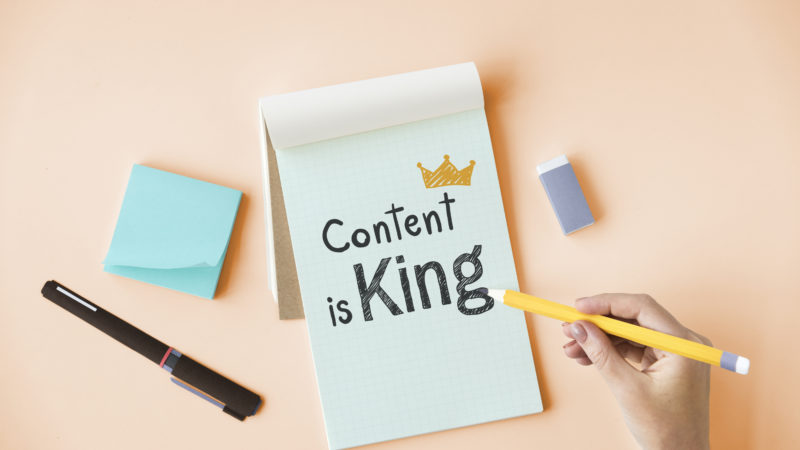Content marketing in the COVID-19 era: how the crisis is affecting the future of content

The drastic socioeconomic impact of the crisis has made companies readjust their marketing strategies and programs since the onset of the coronavirus pandemic.
Traditional marketing methodologies and strategies are undergoing a revolution, meaning we can’t overlook the impact that COVID-19 may have on content creation and distribution. How’s content marketing changing, and what’s its future? Will content still lead? These are the key questions we’ll try to answer today.

From developing integrations to strategic support, from creating creative concepts to optimizing results.
COVID-19 impact on content marketing: let’s give the floor to data
Here, we tell the story in reverse. Let’s start with the answer: content is king now more than ever. We need to work backwards to analyze this statement, which is based first and foremost on figures.
Data show that the coronavirus crisis has affected content marketing much less than other sectors. Orbit Media Studios, in collaboration with the Agency Management Institute, surveyed 122 communication agencies just after the first months of the pandemic—including March and June 2020. Starting from a general overview, the study highlights that only 36% reported slightly negative COVID-19 impacts on marketing while a minority of 25% deemed the effects of the pandemic to be “very negative”.
More specifically, if we zoom in the effects of the crisis on the individual branches of marketing, content is one of the least impacted, just above Web Design/Development and Branding.
The Content Market Institute’s annual research on B2B content marketing also highlights encouraging data:
- 68% of top performers use content marketing for database building and 83% for lead nurturing activities, and
- 84% of the most successful content marketing strategies focus on content to increase user loyalty to the brand and strengthen the relationship with the public.
However, all of 2020 data needs to become available to have a more complete and in-depth picture of the situation based on figures.
In fact, so far, marketers’ figures and opinions have related to a progressing scenario where the pandemic is still hitting.
How COVID-19 has reinforced the importance of content
Nevertheless, we can already begin to draw initial conclusions on how and how much the COVID-19 crisis leaves a mark on content marketing. The relevance and advantage of leveraging content marketing and its power in this critical situation become evident just by looking at the emerging trends of the first phase. Here, the campaigns that went full content hit the spot.
Long before the coronavirus pandemic struck the entire world, the crisis of traditional media was there for all to see. Companies were less and less inclined to invest in traditional advertising and were gradually abandoning the straight push-oriented advertising approach. The coming of COVID-19 and the subsequent forced digitalization abruptly accelerated this process. Companies are increasingly orienting themselves on indirect approaches. Here, the brand doesn’t chase the customer: it’s the customer who seeks its products and services. The drive doesn’t come from advertise aimed at selling and convincing. Rather, the convincing value is the quality and informative nature of the company’s content.
After all, it’s the very current restrictive situation of social distancing and isolation that imposes content as the best communication tool for brands
Spending more time at home, internet usage grew by 50 to 70% and by 12% for streaming services. The circumstances imposed by the pandemic, along with more time, are facilitating the success of Content Marketing. This has become the only way for companies to stay in touch with the public.
Let’s see the concrete advantages of a strategy based on content creation for your company in this historical phase.
Bridging the gap with content
Now more than ever, content marketing is a key asset in bridging the gap and making the public feel your closeness. Through content, you can send messages of solidarity, hope, and support, expressing empathy to users. Further, an effective content marketing strategy can turn into a boredom antidote for your audience and replace your missing traditional services or products.
Beware of advertising content that may sound opportunistic to your public, though. Such risk is just around the corner, given the situation. Content must be designed to add value and respond to the needs of the public. Don’t profit from the current crisis with commercial-like content.
An example worth considering is the IKEA campaign. The Swedish brand has created a series of content that revolves around the concept of reconnecting with your home and taking advantage of the current mobility restrictions. This content marketing strategy allowed IKEA to tune into public sentiment and build a message in line with the brand’s mission. This doesn’t advertise products directly. Rather, it aims at grasping the current needs.

Increase brand loyalty and strengthen brand reputation with content that speaks to the needs of the public
The potential of content can help you spread messages that increase the loyalty of your contacts and strengthen your reputation.
How? This is clear in the two content marketing campaigns designed by Ford and Nike.
- The Ford campaign conveys a message of help to customers in need. This U.S. company decided to extend an existing assistance service to customers affected by emergencies and disasters. By suspending standard advertisements and promoting service-focused content, the company presented itself as close to users and, above all, ready to satisfy their needs. The result in terms of brand loyalty and reputation is excellent.
- Nike, on the other hand, centered its campaign on the following message: “If you ever dreamed of playing for millions around the world, now is your chance. Play inside, play for the world.” Besides this post, the company granted free access to the Nike Training Club app. This subscription includes workout streamings and advice from Nike Master Trainers, with a special page to share commitments and undertakings in addressing the crisis. What an excellent example of social responsibility! Through these initiatives and this type of content, the company focused on a strategy capable of increasing its reputation and credibility. In turn, this further strengthens its relationship with its audience.

Content creates and maintains audience engagement
Moments of boredom and emptiness often characterize the extra time spent home due to the current aforementioned restrictions. Many companies have rushed to fill these moments with their content since the very first phase of the pandemic.
Further, given the impossibility of selling their normal services and products, many companies have had to reinvent themselves. The have capitalized on the creative potential of content marketing to keep their audience engagement rates through new topics. Let’s take a look at some examples:
- Netflix launched the “Wanna talk about it” Instagram series on self-care during a pandemic
- Harvard University made a series of free online lessons on artificial ventilation for medical staff to prepare them in caring for COVID-19 patients
- National Geographic initiated the “Natgeo @ Home” campaign. This series of educational content and resources (quizzes, online lessons, videos, scientific experiments, etc.) can be accessed comfortably from home, totally free
- The Metropolitan Museum of Art gave its users free access to more than 1,600 art books
- Cookist created the “#istayinthekitchen” campaign: video tutorials, ideas, and initiatives for users to make the most of the lockdown and provide insights into the emergency
- Mango launched the “Mango Home Session” initiative, which is a series of acoustic concerts for its Instagram channel users to entertain the social network community and gives visibility to new talents

These examples demonstrate the power of content at a time like this. It not only entertains and engages users but also creates value around the brand to really boost its reputation.
An effective content marketing strategy doesn’t require a big budget
ffordable. Creating an effective content marketing strategy doesn’t have to involve high costs. Quite the opposite! A very smart option, especially at this time, is to avail yourself of user-generated content (UGC), guest posts, and collaborations with influencers to further optimize costs and keep the effectiveness of your campaigns high.
Taking advantage of user-created content allows for saving time, resources, and money, as well as increasing your brand’s sense of solidarity and closeness with the public.
An example of a UGC-marketing strategy is the GoPro campaign launched during the first lockdown. With the #HomePro Challenge, the company invited users to post videos of their home adventures shot with the brand’s products, giving away a prize for the best videos. The campaign not only turned viral, so increasing brand popularity and reputation, but also brought thousands of new subscriptions per day on the economic side of things. Essentially, this became a great example of effective content marketing.
Post-COVID-19 content marketing
The main challenges for what’s next in content marketing
Content Marketing can even leverage the current crisis. However, marketers still feel a step behind since they don’t know how to consciously manage its enormous potential. A CMO Council report revealed how strongly those who work in the sector feel the urge for improvement when it comes to this. In fact, only 12% of marketers believe that their content marketing strategies reach the right audience with relevant content, and only 21% said they work closely with other business departments to enhance service and product demand through content. The common sentiment, therefore, is that content marketing strategies are still stakeholder- rather than public-oriented.
Thus, the next content marketing challenges are as follows:
- being more aware of the relevance of content
- creating content based on the needs and expectations of the public and not the needs of the company
- sharing content that generates value and demand, fostering collaboration between the company departments involved
Can we rely on the same KPIs?
COVID-19 has also had a significant impact on the main KPIs of traditional marketing. This changed the relevance ranking of metrics. Indeed, this situation evidenced the greater importance of qualitative rather than quantitative metrics, also making this true for content marketing.
Without a doubt, qualitative KPIs are more difficult to measure. In fact, they deal with the effects of content, their reception by the public, and the reaction they provoke. However, nobody can deny that these metrics are measurable. To assess the qualitative effectiveness of your content, your company can harness the following:
- surveys, requests for feedback, and interviews with your consumers;
- social and web listening tools; and
- methods for analyzing your reputation.
In general, focus on the sentiment and engagement of your audience to understand if your content is welcomed, if it matches their needs, and if it’s able to engage the audience.
Conclusions
Despite its negative impact, the current COVID-19 crisis doesn’t seem to undermine the relevance and effectiveness of content marketing as a communication tool for companies. Instead, content shines its full potential more than ever. It’s proving to be a valuable ally to bridge the gap, create engagement, protect the company reputation, and create effective strategies with increasingly limited budgets.